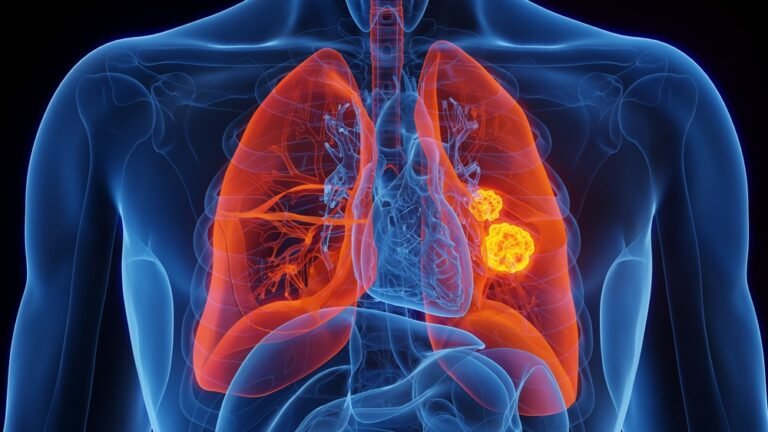Term “non smoker” refers to individuals who have never smoked or have smoked fewer than 100 cigarettes in their lifetime.
There are two categories of lung cancer:
- Small cell lung cancer ( SCC )
Seen exclusively in smokers or ex smokers
- Non small cell lung cancer (NSCC )
It has subtypes
- Adenocarcinoma ( non smokers)
- Squamous cell carcinoma (both smokers and non smokers)
- Large cell carcinoma (in smokers)
- Bronchoalveolar carcinoma (in non smokers)
Adenocarcinoma is most commom lung cancer in non smokers.
Cause of lung cancer in non smokers
The causative factors for lung cancer in non smokers/never smokers are not well understood. The risk factors that are considered to be most important among never smokers are discussed here :
Secondhand smoke — Secondhand smoke is an important risk factor for lung cancer among non smokers. Several studies suggest that approximately 15 to 35 percent of lung cancer among never smokers is due to secondhand smoke and that risk may be increased in those with exposure prior to age 25. There is strong epidemiological evidence that the relative risk to long-term passive smokers is 20–30% above baseline for a spouse or partner, and higher for workplace exposure, and that this causes about 600 lung cancer deaths yearly in the UK.
Breathing secondhand smoke is equivalent to smoking i.e.
- Two hours in a smoky office equal to smoking four cigarettes,
- Two hours in a smoking section of restaurant equals to smoking two cigarettes
- Living together with a pack-a-day smoker for 24 hours means smoking at least three cigarettes.
- Second-hand smoke also has serious and often fatal health consequences. Nonsmokers who are exposed to secondhand smoke at home or at work increase their risk of developing heart disease by 25-30%, stroke by 20−30% and lung cancer by 20-30%.
- Pre-term delivery & low birth weight babies are common in females due to second-hand smoke.
Percentage exposed to second hand smoke (%):
- ADULTS EXPOSED TO TOBACCO SMOKE ON PUBLIC TRANSPORTATION ARE 76.2%
- ADULTS EXPOSED TO TOBACCO SMOKE IN HEALTH CARE FACILITIES ARE 73.6%
- ADULTS EXPOSED TO TOBACCO SMOKE IN RESTAURANTS ARE 86%
- ADULTS EXPOSED TO TOBACCO SMOKE AT HOME AT LEAST MONTHLY ARE 48.3%
- ADULTS EXPOSED TO TOBACCO SMOKE AT THE WORKPLACE ARE 69%
Smoke from cooking and heating —
The indoor burning of unprocessed biomass fuels (wood, coal) is widely used for cooking and heating in many areas of the world and is associated with significant pollution. Such pollution has been associated with multiple respiratory problems, including an increase in the incidence of lung cancer.
The lifelong burning of bituminous coal, which is associated with smoke, was associated with a significant increase in the incidence of lung cancer compared with those individuals who used anthracite (smokeless) coal .The lifetime risk of developing lung cancer was approximately 20 percent for both men and women who used bituminous coal compared with 0.5 percent for those who used anthracite coal. Studies have similarly implicated smoke from wood burning as a significant risk factor for the development of lung cancer.
Air pollution and diesel exhaust —
Studies have shown a significant association between particulate matter air pollution and the incidence of lung cancer.
Multiple studies have demonstrated that exposure to diesel exhaust is associated with an increased risk of lung cancer . This risk is proportional to the extent of exposure.
Although these factors are significantly related to the risk of lung cancer, it should be remembered that their contribution to lung cancer is relatively small quantitatively compared with cigarette smoking.
Environmental exposures —
Other occupational exposures are known to increase lung cancer risk in smokers, and to a lesser extent, in never smokers as well.
- Commonly associated toxins include asbestos, chromium, and arsenic
Asbestos
Asbestos is the general term for a group of naturally occurring fibers composed of hydrated magnesium silicates used for a variety of construction and insulating purposes.
Asbestos fibers are divided into two categories based on their shape.
- Serpentine fibers, of which chrysotile is the main commercial variety, are long, curly strands. Chrysotile accounts for over 90 percent of the asbestos in commercial use in the United States and is generally considered less toxic than the amphibole fibers
- Amphibole fibers (crocidolite, amosite, tremolite, and others) are long, straight, rod-like structures. These fibers are more carcinogenic.
As examples, exposure to asbestos resulted from involvement with the following. - Mining and milling of the fibers
- Industrial and occupational applications of asbestos (e.g, work with textiles, cement, friction materials, insulation, shipbuilding)
- Nonoccupational exposure to airborne asbestos (eg, regular exposure to soiled work clothes brought home by an asbestos worker, renovation or demolition of asbestos-containing buildings, environmental exposure in the neighborhood of industrial sources, and natural environmental exposure to geological sources)
Commercial use of asbestos is banned in many countries. In the United States, asbestos use has been limited since the 1970s, but is still permitted in automotive brake pads and gaskets, roofing products, and fireproof clothing. Mining of asbestos is ongoing in several countries, most prominently Russia, China, Brazil, and Kazakhstan.
Some studies were conducted that showed clear association between asbestos and lung cancer. One of those was a Dutch cohort study of 58279 men that showed 524 cases of lung cancer due to exposure to asbestos. A systematic review and metaanalysis found an increased risk of lung cancer associated with environmental exposure to asbestos , especially in neighbourhood near asbestos mines and factories.
The risk of lung cancer associated with asbestos is greatly magnified by coexisting exposure to tobacco smoke. Risk of dying of lung cancer increases to 16-fold if person smokes more than 20 cigarettes per day and 9-fold if smokes fewer than 20 cigarettes per day, compared with asbestos workers without a regular smoking history. The type of asbestos fiber affects the risk of lung cancer as well; the risk appears to be considerably higher for workers exposed to amphibole fibers than for those exposed to chrysotile fibers. Asbestos exposure increases the incidence of other neoplasms as well. Other malignancies that have been linked to asbestos include cancers of the larynx, oropharynx, kidney, esophagus, and biliary system. Asbestos is the only known risk factor for malignant mesothelioma.
Arsenic
It has been implicated as a cause of lung cancer where it contaminates drinking water, such as in some areas of Taiwan and Chile.
Radon
Radon is a gaseous decay product of uranium-238 and radium-226, which is capable of damaging lining of airways via the emission of alpha particles. The increased risk of lung cancer among uranium miners has been more clearly established and is thought to be due to radiation from radon.
Radon is present in soil, rock, and groundwater, and it can accumulate in homes. Exposure to radon within the home may play a role in the development of lung cancer in never smokers, although this is controversial.
It is a naturally occurring radioactive gas that leaches out of granite. Therefore, people living in houses built upon granite are at an increased risk. This is of considerable importance in countries such as Sweden, and to a lesser extent in the south-west of the UK and in Wales.
Inflammation and benign lung disease —
Various benign lung diseases have been associated with an increased risk of lung cancer, that are mediated through chronic inflammation.
The risk of lung cancer was elevated in patients with :
- COPD /Chronic obstructive pulmonary disease ( Emphysema and Chronic bronchitis)
- pneumonia
- tuberculosis
Other less common benign lung diseases may also be associated with an increased risk of lung cancer:
- Pulmonary fibrosis ( 8- to 14-fold increased risk for lung cancer)
- alpha-1 antitrypsin deficiency (usually the S or Z allele) have an approximately twofold increased risk of lung cancer.
Genetic factors —
The role of genetic factors as a cause of lung cancer is poorly understood, but evidence suggests that such factors play a role. First-degree relatives of individuals with lung cancer have an increased risk of developing lung cancer.
Multiple studies have shown an association between lung cancer in never smokers and a family history of lung cancer, suggesting a role for genetic factors. Specific gene mutations have been identified in with high rates of lung cancer in never smokers. The best understood are gene mutations are in the EGFR ( Epidermal growth factor receptor).
B-vitamins —
Observational data have suggested that B6 and B12 supplements may be associated with an increased risk of lung cancer among men but not women. More data are required to evaluate this risk.
Hormones —
large randomized studies suggest that estrogen plus progestin therapy is associated with an increased risk of lung cancer.
Opium —
Opium is an illicit substance derived from the poppy plant, specifically from the juice of the unripe seedpod, and contains multiple alkaloids. Per the International Agency for Research on Cancer, opium is considered to be carcinogenic to humans when smoked or ingested in various forms (eg, raw, dross, or sap opium)









